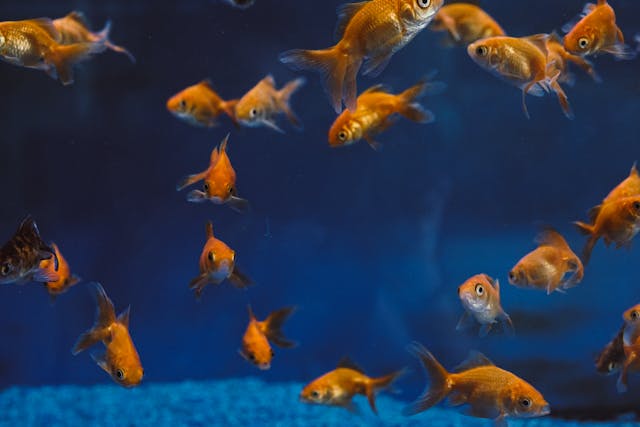How to lower nitrates in fish tank: proven strategies to lower harmful nitrate buildup and maintain safer aquarium water.
Keeping nitrate levels under control in your fish tank isn’t just about clean water, it’s about healthy fish, less algae, and peace of mind. If nitrates creep up, they harm your aquatic world quietly, stressing fish and causing algae blooms. Modern aquarium maintenance increasingly embraces eco-friendly maintenance practices that not only protect your fish but also minimize environmental impact. This guide walks you through everything you need: why nitrates build up, how to measure them, and most importantly, unique, radical, effective ways to get those numbers down, and keep them there.
What You'll Discover:
What Are Nitrates, and Why Should You Care
What nitrates really are
- Nitrate (NO₃⁻) is part of the nitrogen cycle. Ammonia → nitrite → nitrate. The first two are toxic; nitrate is less so, but it accumulates.
- If not removed or processed, high nitrate levels stress fish, lower immunity, prompt disease, stunt growth. In marine and planted tanks, high nitrates also encourage unwanted algae.
What causes nitrate buildup
- Overfeeding. Leftover food decomposes into ammonia, then eventually nitrate.
- Overcrowding. More fish = more waste.
- Poor filtration or insufficient biological filtration. If beneficial bacteria aren’t enough, they can’t convert nitrite efficiently, nor reduce nitrate.
- Infrequent water changes. Water changes are the simplest way to export nitrates.
- Tap water or source water already having nitrates. Sometimes your water supply already has nitrates; every fill or change adds to the tally.
- Dead plant matter, decaying organic material: if plants or decorations decay, they contribute.
Safe vs dangerous levels
- Freshwater tanks: often keep nitrates < 20–40 ppm. Some hobbyists accept higher, but risk increases.
- Saltwater / reef tanks: ideal is much lower, above ~10–20 ppm starts to get risky for corals and invertebrates.
- Different species tolerate different levels. Always know what your fish/inverts/plants can handle.
How to Accurately Measure Nitrates
Before you lower nitrates, you need to know where you stand.
- Use reliable test kits or strips. Color chart kits tend to be more accurate. Calibrate frequently.
- Measure source water (tap/RO/DI) and tank water. This helps you figure out what’s entering vs what’s building up.
- Track nitrates over time, they typically rise slowly in a stable tank, spike if something goes wrong.
Core Strategies to Lower Nitrates
These are time-tested, but I’ll also include some lesser-known or more radical methods so you can choose what fits your setup.
Regular Water Changes
- The simplest, most effective strategy. Replace 20–50% of the water weekly (or more if levels are very high). It physically removes nitrates.
- If nitrates are extremely high (e.g. during cycling or after a big die-off), you can consider doing a large one-time change (50-80%) to knock levels down fast.
- Use water that is low in nitrates (RO/DI or well-tested tap). If your input is already high, repeated changes won’t help long term.
Improve Filtration & Beneficial Bacteria
- Enhance biofiltration. More surface area for bacteria (filter media, porous stones, bio-rings) helps more nitrate to be processed.
- Promote denitrification. That’s the conversion of nitrate into nitrogen gas (which leaves the system). This requires anaerobic zones, places with low oxygen. Deep sand beds, live rock, wet/dry filters or “denitrator” filters help.
- Clean filter media properly. Rinsing in tank water allows bacteria to survive; replacing media too often can collapse the biofilter.
Use Live Plants / Algae
- Plants suck nitrates out of water to build their tissues. Fast-growing plants are especially helpful. Think duckweed, hornwort, water sprite, etc.
- Algae (macroalgae) in saltwater or refugium setups also pull in nitrates. When you trim/remove algae, you are exporting those nitrates
- Keep plants healthy (light, nutrients minus nitrate worry) so they grow vigorously and don’t die and decay themselves (because decay releases nitrates back).
Reduce Input
- Only feed what fish can consume in a few minutes; clean leftovers. Overfeeding is one of the fastest ways to generate nitrates.
- Limit fish density (stocking). More fish = more waste = more ammonia → more nitrate.
- Check source water (tap/RO). If it’s high in nitrates, you may need treatment or using RO/DI water.
Physical & Chemical Methods
- Use nitrate-absorbing media (resins, sponges, pads) that trap nitrates. These work faster but tend to be temporary.
- Protein skimmers (in marine tanks especially) help remove organic matter before it becomes nitrate buildup.
- Activated carbon (if phosphate-free), poly filter pads, etc. These do some job but are not substitutes for water changes and biological control.
Fast-Acting Methods: Emergency Reduction
If your nitrates are dangerously high and fish are suffering, you need to act fast, but carefully.
- Do a large water change (maybe 50-80%) but avoid shocking the fish (match temperature, pH)
- Use partial changes over consecutive days rather than one single massive change, to avoid big shifts in chemistry.
- Move plants or algae into the main tank temporarily to help absorb nitrates quickly.
- Use chemical media that reduce nitrate, but only as a bridge until more sustainable methods (plants, water changes, adjusts) take over.
Radical / Less Known Techniques
These are not standard in every hobbyist’s arsenal, but they work if you understand their quirks.
Carbon Dosing (Organic Carbon Sources)
- Using materials like vodka, sugar, vinegar, or commercial carbon sources to feed denitrifying bacteria. Those bacteria use the carbon and nitrate to grow, converting nitrate into nitrogen gas.
- Needs careful dosing; overshoot can cause other problems (ph drop, oxygen depletion) if unknown or mis-managed.
- Best for saltwater / reef setups, but can be adapted in freshwater systems with care.
Deep Sand Beds & Live Rock / Stacked Media
- Especially for marine/reef tanks, using deep sand beds (DSB) or live rock with low-oxygen cores allows anaerobic bacteria to flourish and complete denitrification.
- The trade-off: maintenance complexity; risk of anaerobic hotspots producing sulfide if mismanaged.
Biopellets and Nitrate-Reducing Reactors
- Biopellets are beads of biodegradable polymer which slowly degrade, releasing carbon that bacteria use to reduce nitrate. Effective in reef tanks.
- Reactors (denitrators) force water through media that facilitates denitrification. More expensive, more complex, but powerful.
Setting Targets & Monitoring Progress
- Set realistic goals: for many freshwater tanks, aim for < 20–40 ppm; reef / planted tanks aim lower (10-20 ppm or less).
- Test weekly at first (or more often if high), then adjust frequency as levels stabilize.
- Record readings: don’t just test once, watch the trend, it tells you if methods are working or drifting.
- Observe your fish: if behavior changes or algae blooms, nitrates likely creep up again.
Examples: How People Did It Right
- A hobbyist had nitrate at ~80 ppm; did three sequential water rotations (draining portions of water, replacing with fresh, mixing) and got down to ~30 ppm in a few hours.
- Another case: during tank cycling, someone went from 90 ppm by doing 75-90% water changes, then daily 30-50% until ammonia/nitrite stable.
- Saltwater systems using macroalgae refugia + biopellets + controlled feeding regularly keep nitrate under 10 ppm. (Not trivial, but possible.)
Common Pitfalls to Avoid
- Doing a huge water change but forgetting to match temperature, pH, hardness → fish stress or shock.
- Letting plants or algae decay in the tank instead of removing them → they become nitrate bombs.
- Relying only on chemical media or fast fixes without addressing root causes (overfeeding, overcrowding). Nitrates will come back.
- Cleaning all filter media or replacing too much at once. Benefit bacteria get wiped out.
How to Maintain Low Nitrates Long-Term
- Set schedule: weekly/biweekly water changes, consistent testing.
- Maintain robust biological filter: media, gravel, live rock, etc.
- Keep plants/algae healthy and trimmed. Remove decaying matter quickly.
- Monitor feeding / stocking strictly.
- Use good source water (RO/DI if needed) to avoid adding nitrates from the start.
Key Takings
- Regular large water changes are the fastest way to physically remove nitrates.
- Biological solutions (plants, algae, anaerobic bacteria) offer sustainable long-term control.
- Reducing inputs (feeding, stocking, source water) prevents nitrate accumulation.
- Radical methods like carbon dosing, biopellets, and denitrators help but need careful management.
- Always monitor: test often, observe fish & algae; chemical readings + behavior = health.
Further Reading:
- How to Quickly Lower High Nitrates in Your Aquarium: Gives actionable methods for efficiently reducing and maintaining safe nitrate levels.
- Getting Nitrates Under Control: Deep dive into advanced reef-tank strategies (carbon dosing, reactors, live rock) with real case examples.





